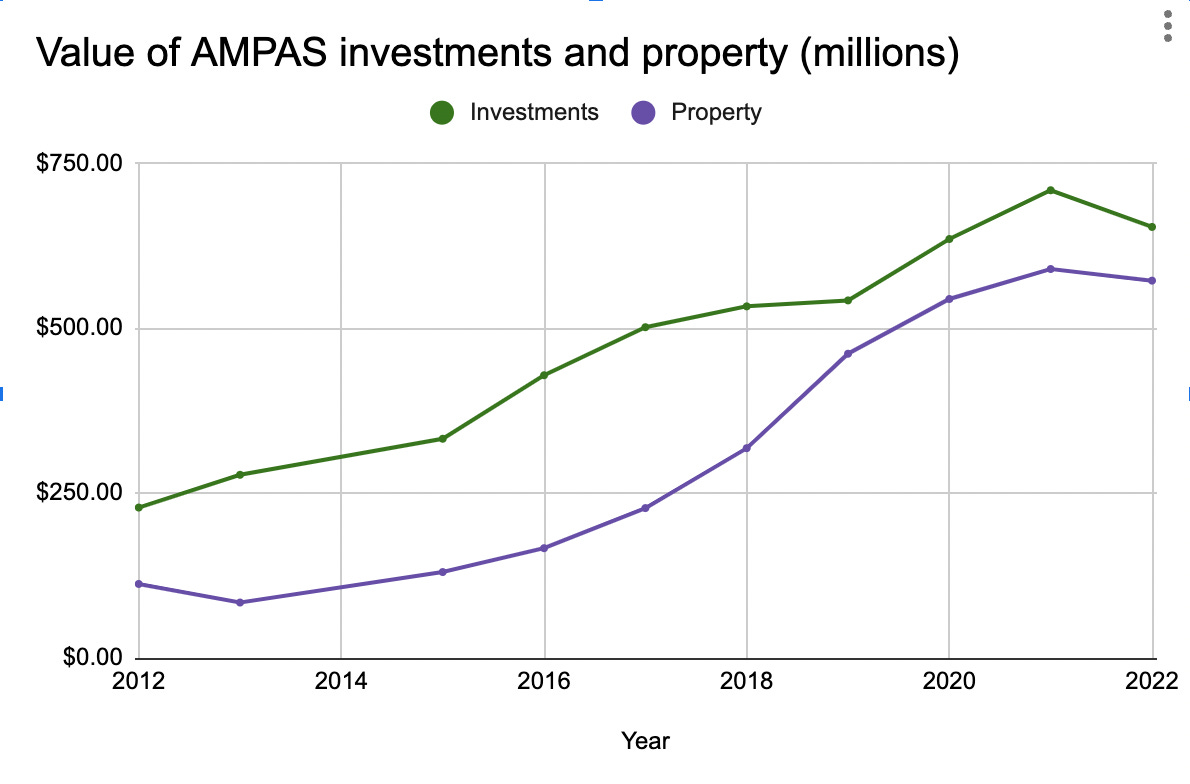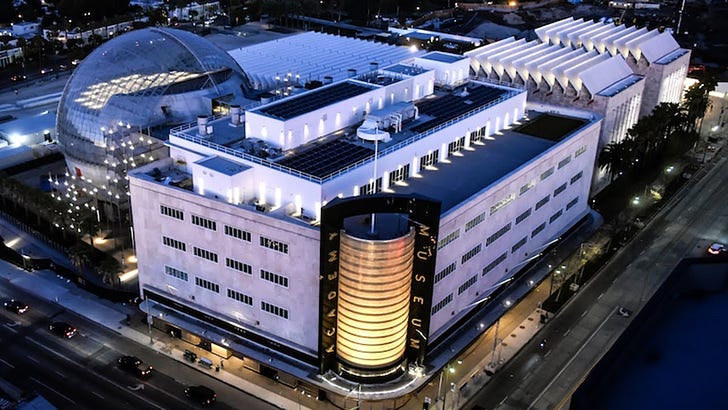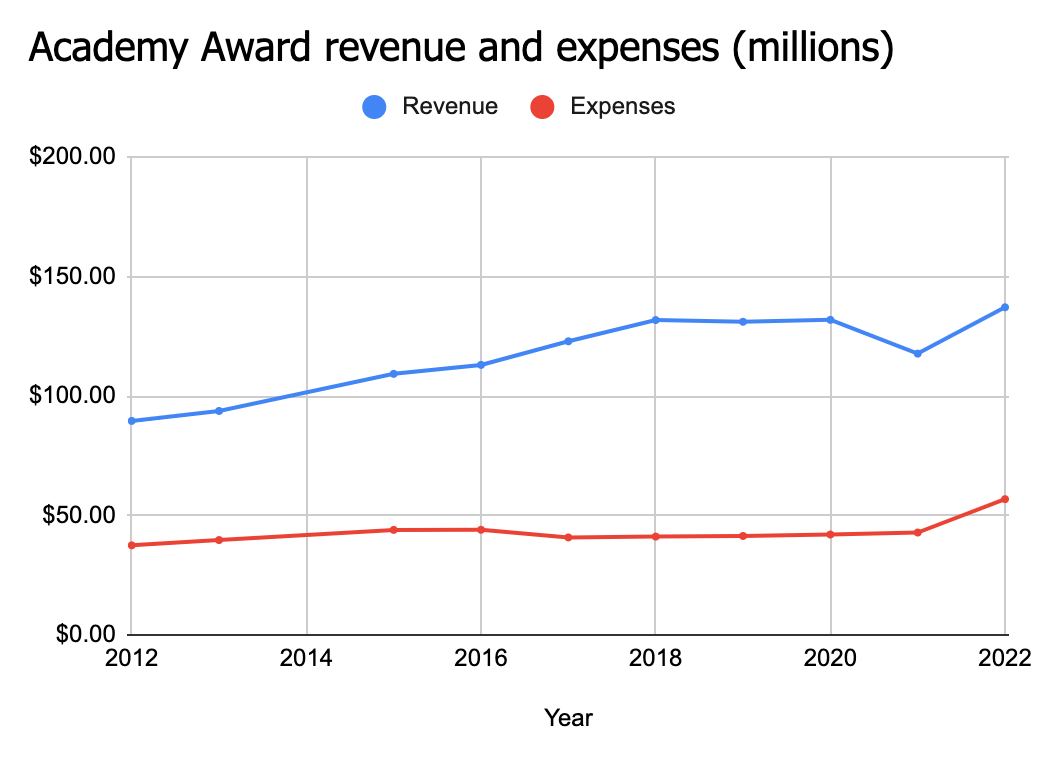Numlock Awards: The Academy is building a bunker that could survive the death of ABC
Numlock Awards is your one-stop awards season newsletter, and it’s back! Every week, join Walt Hickey and Michael Domanico as they break down the math behind the Oscars and the best narratives going into film’s biggest night. Today’s edition comes from Walter.
Last year I did a deep dive into the Academy’s finances, specifically with an eye for what the organization actually is, what had been, and what it was trying to become. The Academy’s books are pretty interesting.
I think this is important. I think that if we want to know how the Oscars are changing and are going to change, it’s worth looking at the books and seeing what we can glean from them about what the organization is headed towards. So I looked at the 2022 financial report, and here’s the gist:
The Academy is trying to transition from a nebulous membership group with some basic assets to a museum with a large endowment.
It’s working pretty well. They make a lot of money from ABC they can then dump into that endowment.
The endowment shrank last year because of the downturn, but less than the S&P 500 did.
The most important year for the Academy is 2028. Their financial state at the end of 2028 will define the organization for decades to come.
A brief history of The Academy
Let’s start with a recent, simplified history of the Academy from a financial perspective based on what I wrote up last year.
The Academy for a while was a membership organization with about 6,000 people in it that picked winners for awards every year, and on the side they used the proceeds to operate a library and a scholarship and a couple of other nice things. Then, the Academy started making a lot of money for their awards, basically making $70 million in profit off the awards every year. This is obviously a remarkable amount of money! They put it in a pile and invested it. Then they got bigger.
Then they took out a lot of loans and built a museum. They had a bunch of money for the museum, but they took out a lot of loans anyway, because rates were cheap. They got a lot of people to donate money and things to that museum. Then, the bottom fell out of network television, and it’s increasingly looking like the obscene money they’re making every year from ABC might not last forever. But the good news is that they’re not really a library that occasionally doles out statues: now they have hundreds of millions of dollars invested in an endowment, and they operate a museum which they can advertise during the awards show.
Their balance sheet — big endowment, splashy real estate lease, annual programming, a group of rich people willing to pay to keep it afloat, and tens of millions of dollars in profit from a national television rights package that is incredibly cheap to fulfill — looks a whole lot like a university, come to think of it. They owe a lot of money, but they also have way more money, and because they have a lot of money they’re probably going to be able to maintain and grow that pile of money indefinitely because that’s how capitalism works past a certain threshold of wealth.
Wait, why a museum?
I get there are criticisms to make about the museum, and a lot of people might consider it a bit of a boondoggle. I don’t know if I buy that, mostly because I think it changes a very important conversation that the Academy probably had a lot which went something like this:
The Academy: Hey, would you like to donate lots of money to us? We produce the second-most watched event on American television and own a library.
Rich, Famous Person: Piss off. Not a lot of incentive there! Now try this:
The Academy: Do you want to buy the naming rights to a place that your rich friends and richer enemies will have to hang out in if they want any chance to win an award?
Rich, Famous Person: Where precisely do I send this check?Now that’s an offer!
There’s a few interesting things that emerged in the Academy’s financial documents.
The investment portfolio took a beating.

The first thing is that they lost $45 million last year on their investments. That’s obviously a huge amount of money, but that’s honestly not particularly awful given that the entire stock market was terrible last year and we’re talking a decline from a $709 million investment portfolio in 2021, so a net 6 percent decline in assets.
To be clear, that sucks. But endowments are built to take financial punches and endure them. The S&P 500 dropped 19.6 percent in 2022, and the Academy’s diversified portfolio weathered the downturn rather well. This is an organization that made $70 million on their investment portfolio in 2021, which was on par with the $74 million they profited from the Academy Awards.
The passive revenue from that portfolio is important and we’re going to get to it more in-depth later because it’s fundamentally the future of the group.
They’re on a ticking clock.
This is not news, per se, but we’ve gotten a little more clarity on timelines and we can do some back of the napkin math.
The Academy is getting $129 million for the 2023 Oscars, $134 million for the 2024 Oscars, $124 million for the 2025 Oscars and then $397 million for the 2026 to 2028 Oscars.
Remember, the Oscars are very profitable. Last year, it cost $56.8 million to put on the award show and they got $137.1 million for broadcasting them, a tidy profit of $80.2 million.
If we assume that it’s going to cost $56 million for the next six award shows, that means that the Academy will have $783.3 million incoming for a cost of $336 million, meaning that we expect that the Academy will earn $447 million over the next six years.
Now, here’s why that matters. The Academy’s cushy contract with ABC is through 2028. In 2024, the Academy will negotiate its new contract for foreign broadcast rights with Buena Vista International, which is also Disney. They also have told the Dolby Theater, where they host the Oscars, that 2028 will be the last year of their agreement, up from 2032.
Ratings on linear television are down. Ratings for the Oscars have not held like the ratings for live sports have. If I had to guess, the Academy isn’t going to be getting $130 million for the Oscars in 2029.
But that $447 million, added on to the current endowment of $654 million, leads to a tidy $1.1 billion. Then add in any financial gains made over the next six years — last year you will recall that AMPAS grew its endowment by $70.3 million on investment return alone — and let’s just say you’re probably looking at an organization with a $1.4 billion war chest, if you assume they attain an average 5 percent annual rate of return.
At $1.4 billion, a 5 percent annual rate of return means a net investment gain of $70 million a year. Which, if you’re recalling our annual math, is pretty damn close to the $80 million a year the Academy already profits from putting on the award show. That’s the financial security. That’s the moat. That’s what ensures that the organization exists even if linear television collapses. Factor in that the Academy saw $41.2 million in cash contributions in 2022 — up from $8.7 million in 2021, a year where the museum was not open — and you’re looking at an organization that has cash flow even if ABC turns off the spigot.
The Museum
Obviously, the Museum costs money too. The museum brought in $23.6 million last year, but museum development and operations cost $93 million last year, plus a $36 million lease. It’ll be interesting to see how that ramps up, if they’re able to make it work. That said, it does seem to be driving donors, and some $117 million in assets was also freed up from donor restrictions upon opening of the museum (up from $9 million the year before) so it does seem to be bringing money in the door.
If the Academy makes the telecast a big annual advertisement for the museum, it could definitely drive visits. But more to the point, the museum does offer some other cost savings when the 2028 reckoning happens.
Worth considering is that the Dolby Theater capacity is 3,400. The David Geffen theater in the Academy Museum has a capacity of 999. If I all of a sudden lost a ton of money on a television contract and needed to slash costs, and I owned my own theater, even if it’s just a stalking horse in a renegotiation, that’s a nice thing to have.
What now?
I have a lot of confidence in the Academy’s ability to weather the times ahead, to be frank. I think the museum was a massive, costly investment that fundamentally changed the organization and made it into something more akin to a university from a balance sheet perspective.
But I think that transition probably saved the organization. They’re getting donors, they’ll get more. They have a physical manifestation of the Oscars for the other 364 days of the year. They have a massive war chest, and it’s only going to bet bigger. If in 2028 ABC wants to cut their annual payment in half, this is now an organization that can likely endure that. I don’t think you could say the same thing for the Academy of ten years ago.



